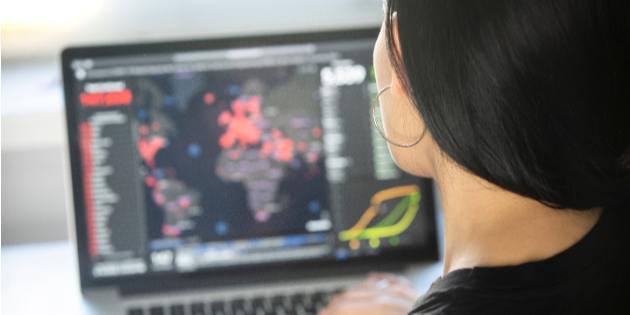
CatwalkPhotos/Shutterstock
Predictive models have played a key role in our fight against COVID-19, helping demonstrate how actions taken by individuals and organizations can affect outcomes. Teresa Waters, professor and chair of Department of Health Management and Policy at University of Kentucky’s College of Public Health, answers our questions regarding predictive models, research practices in COVID-19 times, and moving forward. She shares her perspective as an active member of a working group formed by Kentucky’s Cabinet for Health and Family Services.
Andrew Hibel, HigherEdJobs: Dr. Waters, as discussed in a recent article, you have been involved with modeling predictions for the state of Kentucky to help inform your state decision makers. Can you explain how these models are developed and what they are telling us?
Teresa Waters, professor and chair of Department of Health Management and Policy at University of Kentucky’s College of Public Health: In response to the COVID-19 pandemic, Kentucky’s Cabinet for Health and Family Services (CHFS) formed a working group to model virus spread, hospitalizations, and deaths across the state of Kentucky. There were many publicly available models offering a wide range of (mostly dire) predictions. I am not an epidemiologist but wanted to use my experience studying healthcare delivery to support these efforts.
COVID-19 models are useful for preparedness planning because they make predictions about the range of outcomes (infections, deaths, hospitalizations) that we can expect, depending on actions taken by individuals and organizations (e.g. social distancing; closing schools). Right now, we are estimating that about 1.2 percent of our infected population will eventually require hospitalization, higher for older folks, lower for younger. That is 1.2 percent of the “true infected” (something we estimate), not just those who tested positive. Of those hospitalized, initial data suggested that about 25-40 percent require an ICU bed and 75 percent of ICU patients will require a ventilator.
It is important to understand that models are not making hard and fast predictions; instead, they are offering us choices and paths. One choice might be to do nothing (or very little) to prevent spread. That option has been modeled, and the predicted outcomes are bad. We have also modeled scenarios with mild and strong social distancing measures. This gives us a model with multiple branches. When we did implement relatively strong social distancing measures in Kentucky (and across the US), we were actually “pruning” away the worst branches of the model, leaving us with much better branches/paths/outcomes. Depending on how much social distancing policies are now relaxed, we could see new branches form with worse outcomes (e.g. more hospitalizations, deaths). Updating and monitoring models to make timely predictions of dangerous paths is now our task.
Hibel: You also serve as the Associate Dean for Research for the College of Public Health at University of Kentucky. How has research been impacted in your college?
Waters: When the pandemic hit and the University of Kentucky decided to move to remote operations, it was controlled chaos in our college for a couple of weeks. But we adapted! I was so impressed by how everyone embraced the challenge and figured out how to manage operations remotely. Right now, the vast majority of our research and sponsored programs are fully operational, using a range of tools like ZOOM, TEAMS, OneDrive, email, and phone. Several investigators adapted their studies to include e-consent and distance data collection. Many others are data scientists who barely skipped a beat. A few of our investigators have had to pause interventions and data collection because their studies could only be done face-to-face. We look forward to the day those important studies can resume.
Hibel: How have you been using these models at your institution to help predict how research or other areas of your university could come back?
Waters: The University of Kentucky is relying heavily on guidance from Governor Beshear’s office to plan for a staged reopening, rather than doing our own pandemic modeling. I currently serve on a campus-wide committee that is formulating a plan for “ramping up research” in the next few months, and we are trying to tie stages of campus activity to specific facilities reopening in the state of Kentucky, as well as testing capacity.
I want to point out that research operations at UK did not stop. A great deal of the infrastructure moved to remote operations, but some critical on-campus research operations have remained. This “essential research” includes maintaining animal colonies and providing life-saving treatments (e.g. cancer clinical trial). I would estimate that on-campus research is operating at about 10-15 percent of our normal capacity. As we ramp back up and bring people back to campus, safety is our highest priority. Research operations that require campus presence (e.g. bench research) will return first, with strict protections (e.g. masking, screening for COVID-19 symptoms, social distancing, room/building density guidelines). In general, any research operations that can be done remotely, should continue to be done remotely.
Hibel: How will future funding and grants for research be affected by the pandemic?
Waters: I think we will see a focus shift toward COVID-19 research, a growth in federal funding for all types of research, and a potential contracting of foundation and state funding for research.
Focus shift: We are already seeing a lot of COVID-19 related research opportunities to rapidly address the science of infection, transmission, and immunity, as well as the devastating impact of this virus on disadvantaged populations. I expect that we will continue to see more opportunities in this area, and many of our investigators will lend their skill sets to this new area of research.
Growth in federal funding: In response to the last recession (2008), the federal government used research funding as part of its stimulus package to rebuild the economy (ARRA funding). I think we will see that again for the COVID-19-related economic recession.
Contracting of foundation and state funding: The economic disruption associated with COVID-19 will shrink foundation endowments. States are already grappling with increasing expenditures (COVID-19 response, increasing Medicaid enrollment associated with skyrocketing unemployment), and decreasing revenues (e.g. reduced income and sales tax collections). A wide range of state-funded research projects and health-related programs may be at risk.
Hibel: What ethical issues arise as the demands for predictive modeling increase? And how do you manage the pressure to produce results as the demand increases?
Waters: A major challenge with COVID-19 models is ensuring that everyone, from the average citizen to the state governor, understands their strengths and limitations. That can be very challenging, especially when there are lots of models out there with very different predictions. While academics tend to focus on rigorous details, in this case crafting straightforward messaging is paramount. I’m not sure that is an ethical issue, per se, but it does require thinking carefully about what we say and how we say it.
When facing the demand at the state-level for more and better models, it has been critically important to work as a cooperative group, evaluating the quality of the data and assumptions and preparing updates as soon as possible. Happily, I am not in charge of the working group; our lead in the Cabinet has done a great job of managing expectations.
Hibel: When predictive models report unfortunate conditions on the horizon, perhaps conditions we don’t want to accept, what is the process in disclosing this information to the general public and how do you cope with naysayers?
Waters: The role of the KY working group has been to inform and educate state leadership. It is their job to inform the general public. This has worked well because Kentuckians trust our governor. He has been out front, honest, and communicating often.
Hibel: What type of modifications for the summer or fall have been instituted that affect your staff, faculty, and administrators?
Waters: All summer classes are online. For the College of Public Health, that has been relatively seamless, since most of our summer classes were already online. Our CPH Student Engagement and Academic Success (SEAS) office has done an absolutely phenomenal job connecting with students during this ‘remote’ time to ensure they have what they need and connect them with additional services as needed. That gives us a lot of confidence heading into the summer session. We are waiting to see what the fall session will look like; lots of discussions and planning!
Hibel: A recent quote from President Susan Cole at Montclair State University stated, “We have to keep the heart and soul of this enterprise. It means we have to have the highest quality of instructional programs, we have to continue our research endeavors, and we have to be able to support students to the greatest extent possible to succeed.” How do you think colleges and universities can do this moving forward?
Waters: Things will not look the same as they did before. Universities have to find their ‘new normal’ that allows them to keep people safe and healthy, as well as productive. But college campuses are full of innovative and resilient people who are equal to this challenge. In teaching, we need to seek a new level of excellence in online education, combined with a long-term commitment to maintaining low density on campus. In research, we need to continue to pursue excellence in operating remotely, and when that isn’t possible, we need to maintain procedures to protect the health of employees and participants. We also need to stand up and maintain robust testing and tracing to quickly address the inevitable outbreaks.
These are the logistics of moving forward. As important will be our commitment to supporting the socioemotional health of our community. The ‘new normal’ will be stressful and isolating. We need to create systems that strongly and intentionally support the well-being of our students, staff, and faculty; with this structure in place, we can actually thrive, not just survive.
Hibel: What newly learned experiences or takeaways will you take with you into your future as a leader in higher education and what is something you will leave behind?
Waters: Interesting question! I think one of the biggest takeaways for me has been seeing the value of communicating, early and often. Overcommunicating, really. In stressful situations, people want to hear early and often from their leaders and know what is going on. I’ve also seen how (over) communicating within the leadership team has helped us identify better solutions to challenging situations and helped us work together more effectively.
As far as leaving something behind? It might be the concept that I need to keep up with everything, including old and new tasks and responsibilities. It is just not happening, and that has to be ok! I spend a bit of time at the beginning of each day (before the onslaught of ZOOM meetings) identifying the most important things I need to get done. Other things wait, get delegated, or get apology notes.
